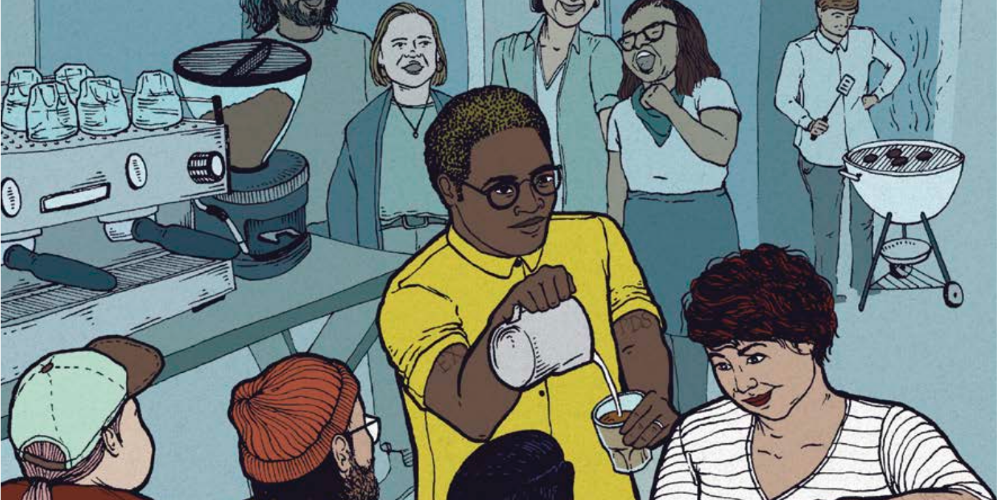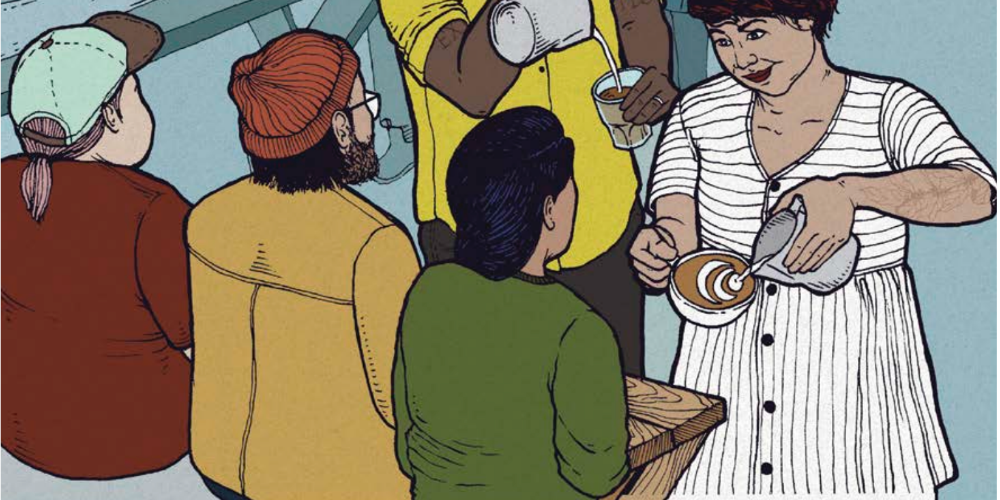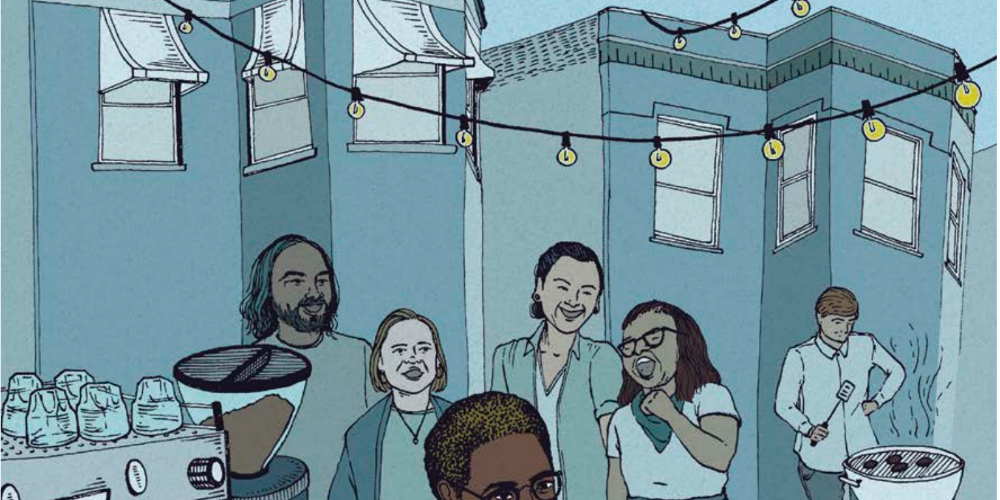Throwdowns and other competitions can be a great way to build camaraderie and community. We have some tips to help you put on a great one!
By Justin Shepherd
Illustration by Ashley Elander Strandquist
“HEY BROTHER!” The voice on the other end of the phone was Jesse Harriott’s, then a roaster at Louisville’s, Ky.’s Sunergos Coffee; the year was 2011. “You should host a throwdown!”
The notion seemed a bit farfetched: Why would a small-time shop like mine in the relatively small town of Bowling Green, Ky., host a throwdown? At the time, we were the only specialty café for at least 60 miles— who would compete? My shop, Spencer’s Coffee, wasn’t very connected to the larger coffee community, and had just started delving into the world of latte art over the past year or so. What we did have, though, were connections to both Louisville, Ky., and Nashville, Tenn., two major cities with rapidly growing coffee communities. Maybe everyone could meet in the middle, at Spencer’s, and form interstate bonds over pints and pours?
Little did we know that over the next seven years, our now-annual throwdown would grow to attract baristas from all over the country, and raise upward of $10,000 for charity—all just by getting together and pouring milk into coffee.

Over the past decade, there’s been a well-documented explosion in specialty-coffee culture. Every major American city has at least a handful of decent independent coffee shops, and wherever there’s a growing coffee community, there’s bound to be the occasional latte art throwdown. For the uninitiated, a “throwdown” is what we specialty-coffee nerds call a relatively informal competition, in which baristas from various shops face off to see who can pour the prettier drink. The moniker belies the all-in-good-fun nature of the contests, which are more about developing a local barista community than they are about winning swag for pretty pours.
While anyone wanting to open a coffee shop can find a wealth of information with a quick Google search—what equipment to buy, how to create good customer flow in the café, how to program and maintain a batch brewer to achieve optimal tastiness on a consistent basis—the ins and outs of hosting a successful throwdown continue to be a mys- tery, if not an afterthought.
Maybe you’ve been to a shoddy throwdown. The competition por- tion didn’t start on time, or the rules weren’t clear, or the beer was too foamy. (Or, worse yet, no beer at all!) Onlookers stood crowded, with little to do besides stare at the backs of other people’s heads, while the presumably beautiful lattes were impossible to see. And as the bracket was whittled down and the throwdown neared what should have
been its dramatic climax, most of the onlookers had already departed because the whole thing was, well, just plain boring.
Latte art throwdowns have a ton of potential for community building, for charitable fundraising, and even for marketing your business or brand, but capitalizing on that potential can be tricky. When we hosted the first Kentucky/Tennessee Latte Art Throwdown in 2011 (since rebranded to My Old Kentucky Throwdown), we didn’t have a clue what we were getting into. We’ve made a ton of mistakes, but we’ve learned from them, and our event has gotten larger—and gone more smoothly each year. Our little throwdown now has a nationwide draw, boasting a 64-competitor bracket and prize packages that rival those of national competitions. More importantly, we’ve raised thousands of dollars for a number of charities, and created an annual time and place for the wider coffee community to connect and cavort.
With that in mind, here are some of the essentials that can make your first throwdown a success—or your next one a little less crappy.

GETTING BUY-IN (and not just registrations)
Attracting participants is an obvious need—without competitors, there’s no competition. Equally important is getting physical “buy- in” from anyone who’s going to help (and you’ll definitely need help).
That probably starts with your own café’s team, but it can also include baristas from other area shops, and even regular customers who have the coffee bug. In our first year, we had an everyday customer named Arthur fill the role of official “shot-puller” (many throwdown organizers designate someone to pull shots so that the only thing competitors have to concentrate on is pouring). Arthur got to learn a little about coffee, and we were able to focus on the trickier aspects of the evening. Spend a few minutes thinking through your event, and you’ll realize a long list of needs: Someone to take registrations, someone to emcee, someone to wash cups, someone to play gofer. For every piece of your event, you’ll need at least one or two volunteers, so make a list and check it twice.
Of course, promoting your event well ahead of time will help you find those volunteers. Which leads me to …
PROMOTE EARLY AND OFTEN
If you’re hoping to attract baristas from other shops—and you definitely should—you’ll need to make them aware of what’s going on. Posters and Facebook event pages are great, but for maximum partic- ipation, consider calling other shops in your area and speaking to the managers well ahead of time. With a little luck, your event will become a great team-building opportunity for these folks, and interested parties will have plenty of time to request off work.
Pre-registration has been a huge help to us over the years. Printing something as simple as “email to preregister” on your flyer can help you gauge interest on the front end, and save a few steps on the night of the event. We’ve even taken registration fees (aka buy-ins) through PayPal, reducing the chance of no-shows and making the event itself that much simpler.
While you’re at it, make sure to let area media outlets know about the event. Chances are a local TV station would love to come film for a few minutes: “Baristas nerd out” might be a trope, but it’s one you can easily use to get some free publicity for your business.
SEEK OUT SPONSORS EARLY
Believe it or not, there are a ton of awesome companies out there that would love to sponsor your throwdown! (The fine folks at Pacific Foods are the headline sponsor of My Old Kentucky Throwdown, and have matched their generous donations of prize money with equal donations to charity.) From roasters to equipment manufacturers, to apparel companies, craft breweries, nearby local businesses, and this very magazine you’re reading now, there are a lot of generous people who will be happy to help.
First, you need to start soliciting sponsors as soon as you’ve hatched your idea. A lot of these companies will have a budget for this sort of thing, but they’re also working months ahead of time. Emails are OK, but real telephone calls are best. Briefly explain your event, a rough idea of attendance, and what the sponsor can expect in exchange for their generosity (name or logo featured on posters, social media promotion in advance and after the throwdown, shout- outs during the event, etc.), and you’ll be surprised at the enthusiastic responses you’ll receive. You’ve got to hold up your end of the bargain, though, and commit to following up with the sponsors after the event: Send pictures and a brief wrap-up, at a minimum, but also highlight any media exposure you may have received from your local news outlet, coffee blogs, or even Barista Magazine.

CONSIDER YOUR COMMUNITY
Building camaraderie and relationships among area cafés is a worthy enough goal, but don’t stop there: An event like this is a great way to give back to the community that buys your coffee each and every day. We decided from day one that our throwdowns would benefit charities and nonprofits, and we’ve never once regretted it. My two sons are on the autism spectrum, and over the years we’ve raised thousands of dollars for a handful of organizations that serve affected individuals and their families. With sponsors providing the prizes, competitors’ registration fees can go directly to charity, and there are plenty of other ways to raise even more.
We solicit small donations from businesses (both coffee and otherwise) throughout our area, then sell raffle tickets to audience members. We also hold an “auction round” during the competition, in which onlookers get to bid on and drink the lattes being poured. Get a food truck to show up and donate a portion of their sales, and give attendees an up-close-and-personal look at the organization you’re supporting by inviting a representative to share a brief word about what they do in your community.
AUDIENCE EYES
In the café, we’re constantly looking at our spaces through customers’ eyes, and the dif- ference between putting on an OK throwdown and an awesome one comes down to a similar mindset. What will the audience see? Maybe you can have a camera trained on the judging area, and images of the lattes projected for all to see. Where will onlookers go? Think about that as you arrange tables, displays, and whatnot. How will they know what’s going on? Make sure you’ve given your emcee all the info you want communicated—explanations
at the outset, enthusiastic updates as the competition unfolds, and plenty of shout-outs for your sponsors. If possible, give onlookers something to do besides just watching: free coffee tastings at the rear of the room, perhaps, or even a “Barista 101” booth with a one-group machine and a barista to teach basic milk steaming. A silent auction, or an art show featuring work by local coffee folks, artists, or schoolchildren, can be a great draw and expand the crowd you’re attracting to the event. Whatever you come up with, give some thought to making the entire affair—not just the competition—engaging to anyone who happens by.
CLEAR EXPECTATIONS
Two frequent sore spots at throwdowns: unclear judging and poor communication. It sucks to spend time and money to compete in a throwdown, only to feel that the judging was unfair, or to find out you’re only allowed to pour swans into cortado cups. Fortunately, both pitfalls are easy to avoid.
For starters, let participants know about any special rules they’ll be expected to follow. If there’s going to be a dice round, communicate that ahead of time; if you expect them to bring their own pitchers and cups, make sure that’s communicated well ahead of the event.
As for judging, create clear parameters (or use the widely regarded Coffee Fest criteria, minus the speed point; see www.coffeefest.com), and make sure to calibrate your judges just prior to the competition getting underway. Speaking of judges, make sure your judging panel is as diverse as possible, with representatives from multiple shops so as to avoid bias. You might even consider inviting a local celebrity to judge alongside two seasoned coffee pros.
None of that ensures that no one will gripe—there’s bound to be a controversial call or two—but it will make for a better event, and help you sleep better at night.
WHAT ABOUT WASTE?
A frequent complaint about throwdowns is the amount of waste involved: All that espresso and milk, going down the drain! But it needn’t be that way. If you’d like your throwdown to be more sustainable, consider handing out the finished lattes to customers. Everyone likes free coffee, right? (Of course, if you go this route, you’ll need to make sure baristas are following best practices with regard to sanitation for their cups, their hands, and your machine. Any barista worth their salt should be doing this in the first place!) At My Old Kentucky Throwdown, we accept donations for competitors’ drinks, which just sweetens the pot for our charity of choice.
ORGANIZE + EXECUTE
Once your event starts, you’ll want to enjoy it—but in order to do that, you’ll need to have planned ahead. A day or two prior, write down everything you could possibly need, then make sure you have it. Sketch out your competition area, and have a plan for who goes where and when. Walk through your space and imagine it all; write down questions you don’t have answers to, and potential problem areas, then plan for those issues while you still have time.
For the competition itself, set up a free account at www.challonge.com (yes, spelled with an “o”) for foolproof bracketing, and assign a volunteer to fill it in and keep it updated throughout the event. You’ll likely want to “randomize” the bracket, which you can do once you’ve entered all your competitors, but I’d also suggest giving the randomized bracket a quick glance: There’s a good chance two baristas from the same shop will be paired against each other in the first round, and this always leads to frus- tration. Have an unbiased third party help you swap out the occasional coworker match, if possible. Once you’ve activated your bracket, share the web address with your audience, and they can follow along through out the evening.
Gather your volunteers early and give them clear assignments, and encourage them to snap pictures or video throughout the evening, so you can show off your success in the days and weeks to come. Create a hashtag and publicize it around the space so that your attendees tag their Instagram posts and tweets, thus giving your throwdown (and your business) even wider exposure. Make sure your judges have a decent place to sit, access to beverages, and a bathroom break somewhere in the schedule. Get some “Hello, My Name Is” labels to help dial back any awkwardness, and take a walk around the block before everything gets rolling!
With any luck, your throwdown will be a smashing success—for baristas, for your company, and for your community.
Read our Throwdown To-Do List to make sure you’ve to everything you need to make your event great here.
Don’t forget you can request event support from Barista Magazine here, and we will send you swag, prizes, magazines, and more.
This article originally appeared in the April + May 2019 issue of Barista Magazine.
